Effect of Supercritical CO2 Drying on Moisture Transfer and Wood Property of Eucalyptus urophydis
Abstract
1. Introduction
2. Materials and Methods
2.1. Materials
2.2. Equipment
2.3. Drying Test
2.4. Determination of Moisture Content and Its Distribution and Drying Rate
2.5. Determination of Extracts of Wood Dried after Supercritical CO2 Drying
2.6. Microstructure Characterization of Wood after SCD
2.7. Permeability Evaluation of Wood Dried after Supercritical CO2 Drying
3. Results and Discussion
3.1. Characteristics of Drying Rate
3.2. Moisture Content Distribution
3.3. Characteristics of Moisture Content Gradient
3.4. Extractives of Wood Dried after Supercritical CO2 Drying
3.5. Microstructure Characterization of Wood after Supercritical CO2 Drying
3.6. Permeability of Wood Dried after Supercritical CO2 Drying
4. Conclusions
Author Contributions
Funding
Acknowledgments
Conflicts of Interest
References
- Yang, L.; Mao, H.Z.; Liu, H.H.; Wu, Z.H. Effect of Freezing and Compressing Pre-treatment on Collapse of Eucalyptus urophylla E. grandis during Drying. J. For. Eng. 2018, 3, 30–34. [Google Scholar] [CrossRef]
- Ananias, R.A.; Sepulveda-Villarroel, V.; Perez-Pena, N.; Leandro-Zuniga, L.; Salvo-Sepulveda, L.; Salinas-Lira, C.; Cloutier, A.; Elustondo, D.M. Collapse of Eucalyptus Nitens Wood after Drying Depending on the Radial Location within the Stem. Dry. Technol. 2014, 32, 1699–1705. [Google Scholar] [CrossRef]
- Blakemore, P.; Northway, R. Review of, and Recommendations for, Research into Preventing or Ameliorating Drying Related Internal and Surface Checking in Commercially Important Hardwood Species in South-eastern Australia. In FWPA Project: PNB047-0809; FWPA: Federal Way, WA, USA, 2009. [Google Scholar]
- Wu, Y.H.; Jia, R.; Ren, H.Q.; Zhou, Y.D.; Xing, X.T.; Wu, Z.K.; Wang, Y.R. Study on Radial Variation of Main Physical Properties of Imported Pinus radiata Wood. J. For. Eng. 2019, 4, 48–53. [Google Scholar] [CrossRef]
- Chafe, S.C. The Distribution and Interrelationship of Collapse, Volumetric Shrinkage, Moisture Content and Density in Trees of Eucalyptus Regnans F. Muell. Wood Sci. Technol. 1985, 19, 329–345. [Google Scholar] [CrossRef]
- Kauman, W.G. Cell Collapse in Wood—Part I: Process Variables and Collapse Recovery. Holz. Roh. Werkst. 1964, 22, 183–196. [Google Scholar] [CrossRef]
- Kong, L.L.; Zhao, Z.J.; He, Z.B.; Yi, S.L. Development of Schedule to Steaming Prior to Drying and Its Effects on Eucalyptus Grandis × E. Urophylla Wood. Eur. J. Wood Wood Prod. 2018, 76, 591–600. [Google Scholar] [CrossRef]
- Peres, M.L.; Delucis, R.D.A.; Gatto, D.A.; Reltrame, R. Solid Wood Bending of Eucalyptus grandis Wood Plasticized by Steam and Boiling. Ambient. Constr. 2015, 15, 169–177. [Google Scholar] [CrossRef][Green Version]
- Zhang, Y.L.; Miao, P.; Zhuang, S.Z.; Wang, X.M.; Xia, J.W.; Wu, L.M. Improving the Dry-Ability of Eucalyptus by Pre-Microwave or Pre-Freezing Treatment. J. Nanjing For. Univ. 2011, 35, 61–64. (In Chinese) [Google Scholar]
- Vermaas, H.F. Drying Eucalypts for Quality: Material Characteristics, Pre-Drying Treatments, Drying Methods, Schedules and Optimization of Drying Quality. S. Afr. For. J. 1995, 174, 41–49. [Google Scholar] [CrossRef]
- Santos, J.A. Recovering Dimension and Form in Collapse Distorted Boards. In Proceedings of the 4th Cost E15 Workshop, Santiago de Compostela, Spain, 30–31 May 2002. [Google Scholar]
- Hansmann, C.; Stingl, R.; Prieto, O.G.; Lopez, C.B.; Resch, H. High-Frequency Energy-Asisted Vacuum Drying of Fresh Eucalyptus globulus. Dry. Technol. 2008, 26, 611–616. [Google Scholar] [CrossRef]
- Yang, L.; Ma, Q.Y.; Liu, H.H.; Liao, X.M.; Wu, Z.H. Freeze-Drying Properties of Eucalyptus urophylla × E.grandis Wood. J. For. Environ. 2018, 38, 277–283. (In Chinese) [Google Scholar]
- Gabitov, R.F.; Khairutdinov, V.F.; Gumerov, F.M.; Gabitov, F.R.; Zaripov, Z.I.; Gaifullina, R.; Farakhov, M.I. Drying and Impregnation of Wood with Propiconazole Using Supercritical Carbon Dioxide. Russ. J. Phys. Chem. B 2017, 11, 1223–1230. [Google Scholar] [CrossRef]
- Cabeza, L.F.; de Gracia, A.; Fernández, A.I.; Farid, M.M. Supercritical CO2 as Heat Transfer Fluid: A Review. Appl. Therm. Eng. 2017, 125, 799–810. [Google Scholar] [CrossRef]
- Ramsey, E.; Sun, Q.B.; Zhang, Z.Q.; Zhang, C.M.; Gou, W. Mini-Review: Green sustainable processes using supercritical fluid carbon dioxide. J. Environ. Sci. 2009, 21, 720–726. [Google Scholar] [CrossRef]
- Franich, R.A.; Gallagher, S.; Kroese, H. Dewatering Green Sapwood Using Carbon Dioxide Cycled between Supercritical Fluid and Gas Phase. J. Supercrit. Fluids 2014, 89, 113–118. [Google Scholar] [CrossRef]
- Dawson, B.S.W.; Pearson, H.; Kroese, H.W.; Sargent, R. Effect of Specimen Dimension and Pre-heating Temperature on Supercritical CO2 Dewatering of Radiata Pine Sapwood. Holzforschung 2015, 69, 421–430. [Google Scholar] [CrossRef]
- Zuo, C.L.; Cao, Y.J.; Zhou, Y. A Review of Formation Mechanism and Control of Collapse in Eucalyptus Wood. World For. Res. 2016, 29, 58–63. (In Chinese) [Google Scholar] [CrossRef]
- Dawson, B.S.W.; Pearson, H. Effect of Supercritical CO2 Dewatering Followed by Oven-Drying of Softwood and Hardwood Timbers. Wood Sci. Technol. 2017, 51, 771–784. [Google Scholar] [CrossRef]
- Dawson, B.S.W.; Pearson, H.; Kimberley, M.O.; Davy, B.; Dickson, A.R. Effect of Supercritical CO2 Treatment and Kiln Drying on Collapse in Eucalyptus nitens Wood. Eur. J. Wood Wood Prod. 2020, 78, 209–217. [Google Scholar] [CrossRef]
- Li, Z.; Lu, J.X.; Cao, J.Z.; Jiang, J.L. Comparative Study of the Hydrothermal Softening Characteristics of Heartwood and Sapwood. For. Prod. J. 2020, 70, 243–248. [Google Scholar] [CrossRef]
- Zhang, J.W.; Liu, H.H.; Yang, H.; Yang, L. Drying Characteristics of Eucalyptus urophylla × E. grandis with Supercritical CO2. Materials 2020, 13, 3989. [Google Scholar] [CrossRef] [PubMed]
- Behr, V.C.; Hill, S.J.; Meder, R.; Sandquist, D.; Hindmarsh, J.P.; Franich, R.A.; Newman, R.H. Carbon-13 NMR Chemical-shift Imaging Study of Dewatering of Green Sapwood by Cycling Carbon Dioxide between the Supercritical Fluid and Gas Phases. J. Supercrit. Fluids 2014, 95, 535–540. [Google Scholar] [CrossRef]
- Newman, R.H.; Franich, R.A.; Meder, R.; Hill, S.J.; Kroese, H.; Sandquist, D.; Hindmarsh, J.; Schmid, M.W.; Fuchs, J.; Behr, V.C. Proton Magnetic Resonance Imaging used to Investigate Dewatering of Green Sapwood by Cycling Carbon Dioxide between Supercritical Fluid and Gas Phase. J. Supercrit. Fluids 2016, 111, 36–42. [Google Scholar] [CrossRef]
- Meder, R.; Franich, R.A.; Callaghan, P.T.; Behr, V.C. A Comparative Study of Dewatering of Pinus Radiata Sapwood using Supercritical CO2 and Conventional Forced Air-drying via in situ Magnetic Resonance Microimaging (MRI). Holzforschung 2015, 69, 1137–1142. [Google Scholar] [CrossRef]
- Franich, R.A.; Meder, R.; Falge, M.; Fuchs, J.; Behr, V.C. Uncovering Supercritical CO2 Wood Dewatering via Interleaved 1H-imaging and 13C-spectroscopy with Real-time Reconstruction. J. Supercrit. Fluids 2019, 144, 56–62. [Google Scholar] [CrossRef]
- Ehsan, M.M.; Guan, Z.Q.; Klimenko, A.Y. A Comprehensive Review on Heat Transfer and Pressure Drop Characteristics and Correlations with Supercritical CO2 under Heating and Cooling Applications. Renew. Sustain. Energy Rev. 2018, 92, 658–675. [Google Scholar] [CrossRef]
- Jiang, T.; Zhou, Z.F.; Wang, Q.W. Effects of Intensive Microwave Irradiation on the Permeability of Larch Wood. Scientia Silvae Sinicae 2006, 42, 87–92. [Google Scholar] [CrossRef]
- Fernandes, J.; Kjellow, A.W.; Henriksen, O. Modeling and Optimization of the Supercritical Wood Impregnation Process-Focus on Pressure and Temperature. J. Supercrit. Fluids 2012, 66, 307–314. [Google Scholar] [CrossRef]
- Hou, S.X.; Maitland, G.C.; Trusler, M. Measurement and Modeling of the Phase Behavior of the (Carbon Dioxide + Water) Mixture at Temperatures from 298.15K to 448.15K. J. Supercrit. Fluids 2013, 73, 87–96. [Google Scholar] [CrossRef]
- Phillips, E.W.J. Identification of Softwoods by Their Microscopic Structure. In Forest Products Research Bulletin No.22; DSIR: London, UK, 1948; Volume 22, pp. 1–56. [Google Scholar]
- Way, D.; Kamke, F.A.; Sinha, A. Moisture Transport in Wood-Based Structural Panels under Transient Hygroscopic Conditions. For. Prod. J. 2020, 70, 283–292. [Google Scholar] [CrossRef]
- Peng, W.X.; Wu, X.B.; Wu, Y.Q.; Chen, H. Analysis of Benzene/Ethanol Extractives from Flesh and Old Eucalyptus urophydis Chips by Py-GC/MS. JSCUT 2009, 37, 67–74. [Google Scholar]
- Cornelio-Santiago, H.P.; Gonçalves, C.B.; de Oliveira, N.A.; de Oliveira, A.L. Supercritical CO2 Extraction of Oil from Green Coffee Beans: Solubility, Triacylglycerol Composition, Thermophysical Properties and Thermodynamic Modelling. J. Supercrit. Fluids 2017, 128, 386–394. [Google Scholar] [CrossRef]
- Kjellow, A.W.; Henriksen, O. Supercritical Wood Impregnation. J. Supercrit. Fluids 2009, 50, 297–304. [Google Scholar] [CrossRef][Green Version]
- Pearson, H.; Dawson, B.; Kimberley, M.; Davy, B. Predictive Modelling of Supercritical CO2 Dewatering of Capillary Tubes. J. Supercrit. Fluids 2019, 143, 198–204. [Google Scholar] [CrossRef]
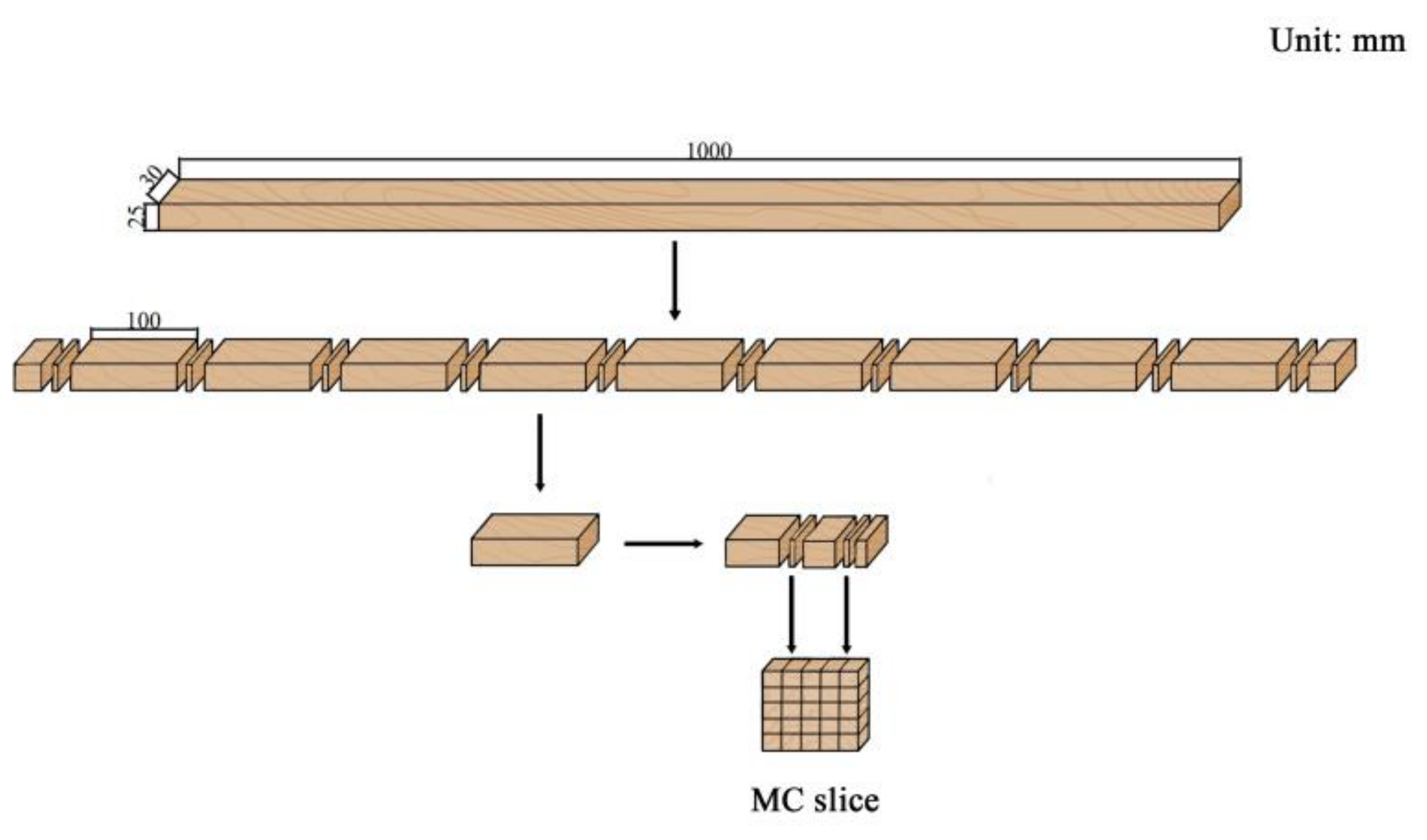
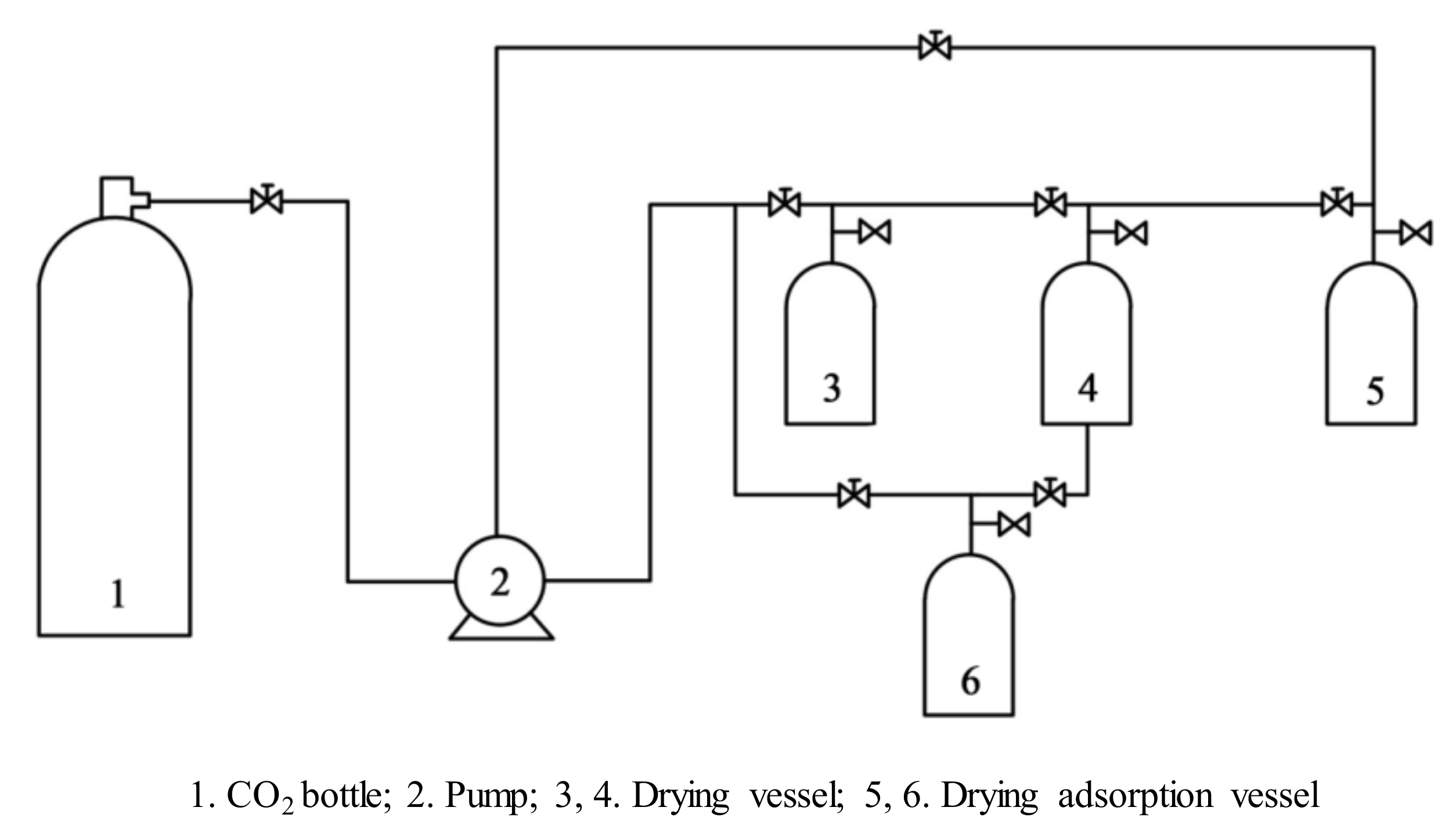
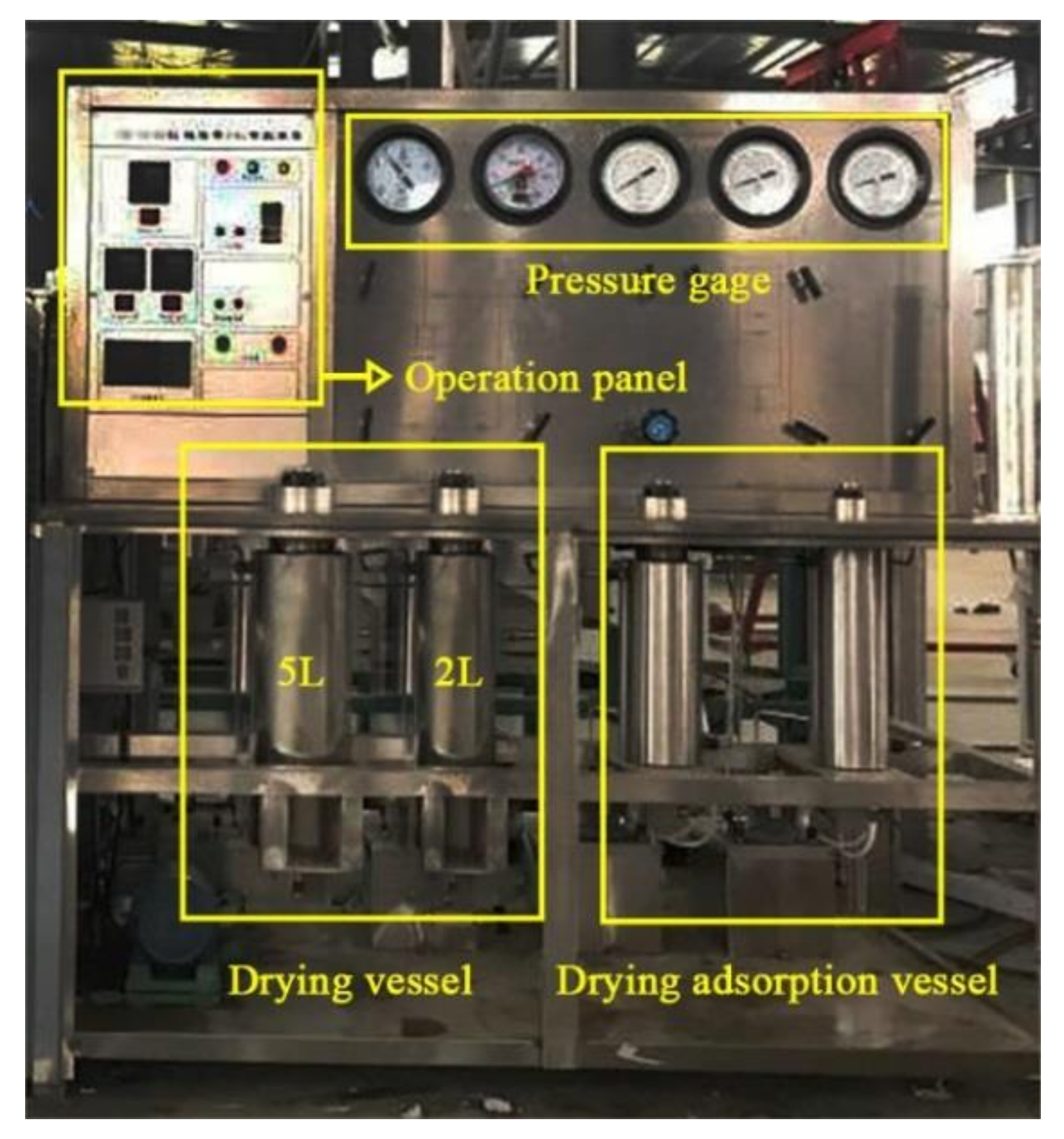
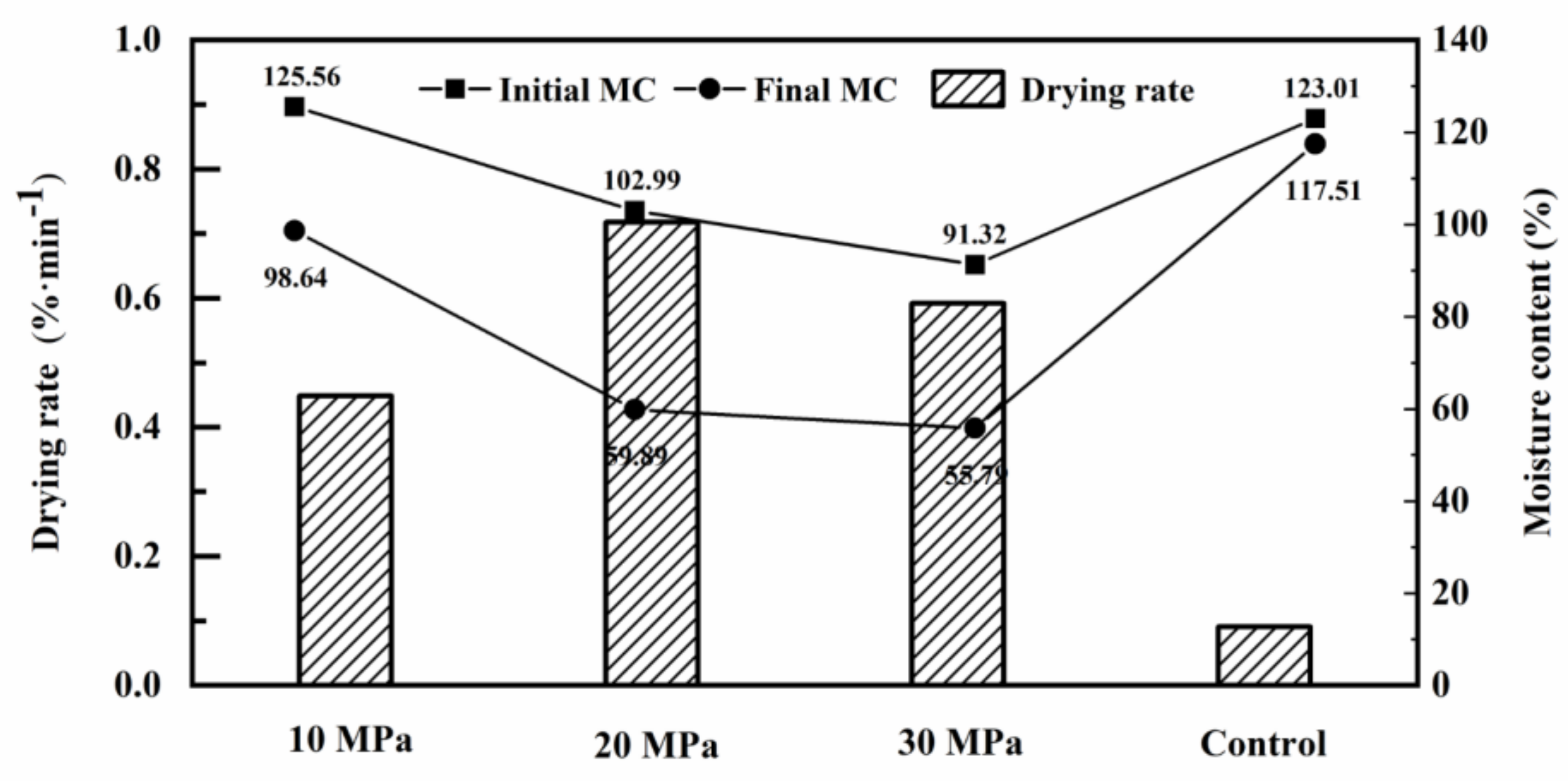

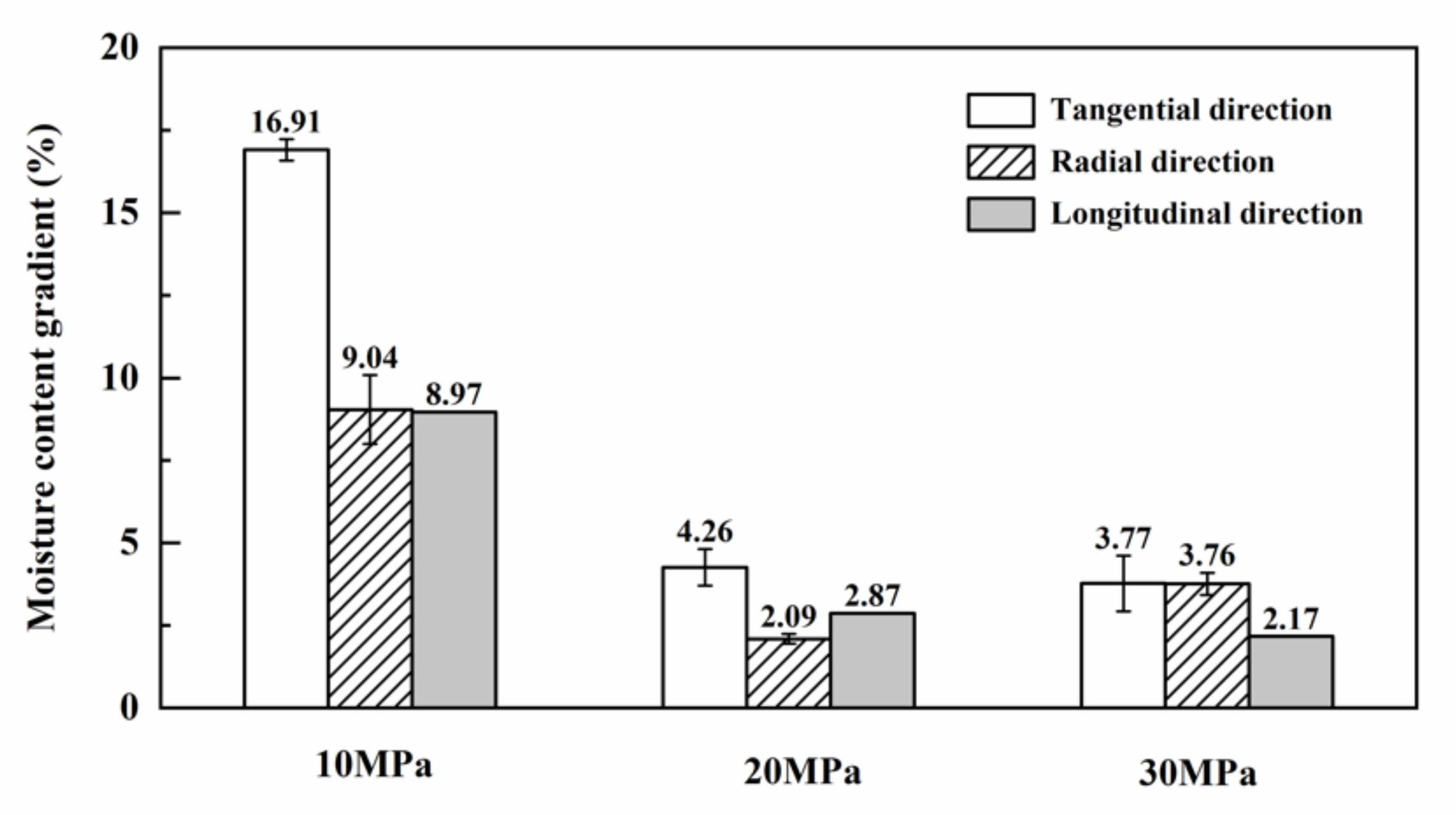
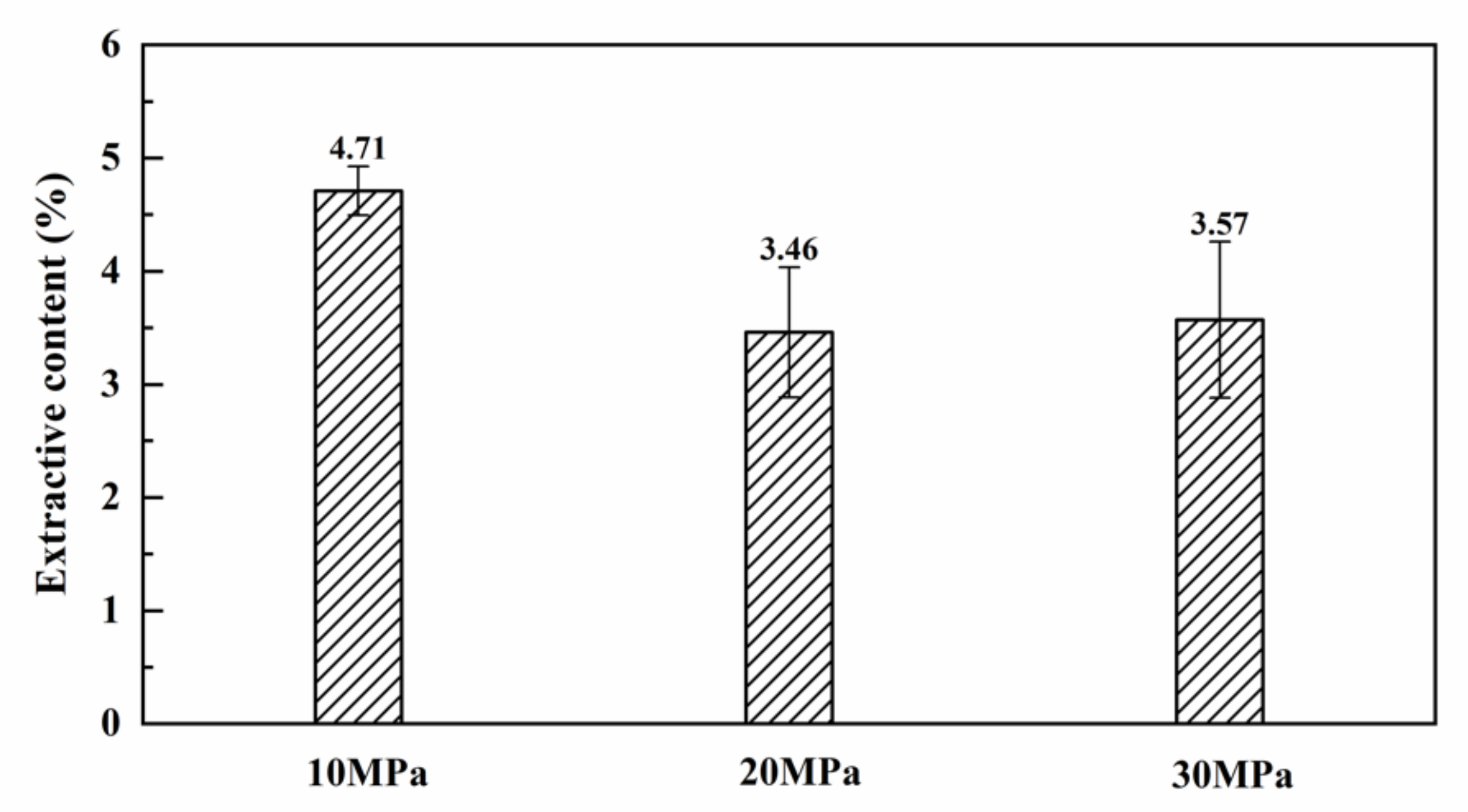
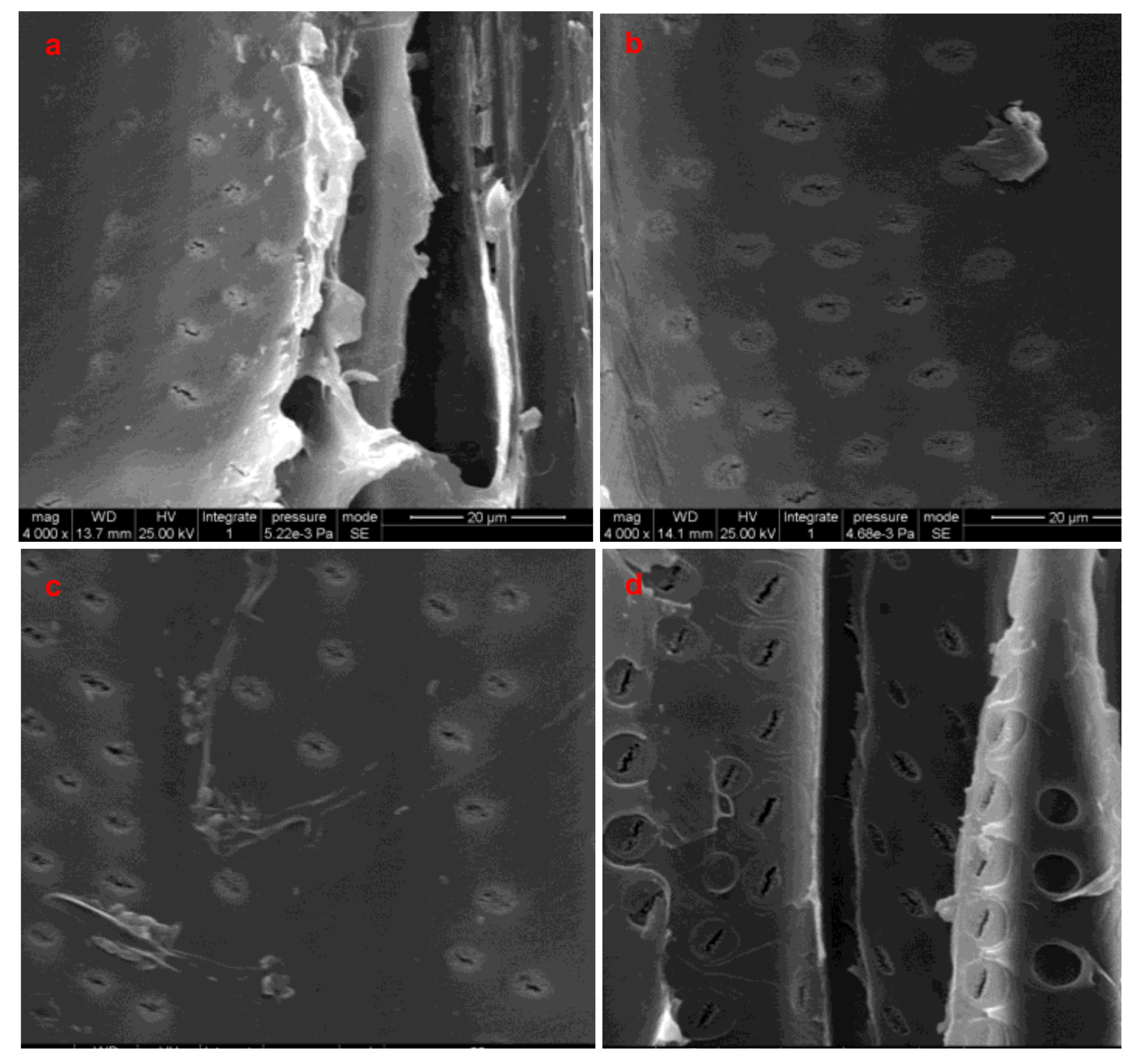

| Process Parameter | Value |
|---|---|
| Pressure max (MPa) | 10/20/30 |
| Pressure min (MPa) | 0.1 |
| Pressurization time (min) | 10~30 |
| Hold (min) | 60 |
| Decompression (min) | 10 |
| CO2 emission (min) | 30 |
| Supercritical temperature (°C) | 50 |
Publisher’s Note: MDPI stays neutral with regard to jurisdictional claims in published maps and institutional affiliations. |
© 2020 by the authors. Licensee MDPI, Basel, Switzerland. This article is an open access article distributed under the terms and conditions of the Creative Commons Attribution (CC BY) license (http://creativecommons.org/licenses/by/4.0/).
Share and Cite
Yang, L.; Liu, H. Effect of Supercritical CO2 Drying on Moisture Transfer and Wood Property of Eucalyptus urophydis. Forests 2020, 11, 1115. https://doi.org/10.3390/f11101115
Yang L, Liu H. Effect of Supercritical CO2 Drying on Moisture Transfer and Wood Property of Eucalyptus urophydis. Forests. 2020; 11(10):1115. https://doi.org/10.3390/f11101115
Chicago/Turabian StyleYang, Lin, and Honghai Liu. 2020. "Effect of Supercritical CO2 Drying on Moisture Transfer and Wood Property of Eucalyptus urophydis" Forests 11, no. 10: 1115. https://doi.org/10.3390/f11101115
APA StyleYang, L., & Liu, H. (2020). Effect of Supercritical CO2 Drying on Moisture Transfer and Wood Property of Eucalyptus urophydis. Forests, 11(10), 1115. https://doi.org/10.3390/f11101115




